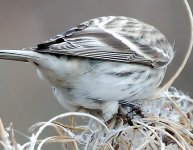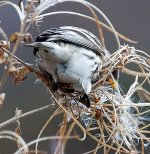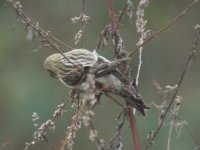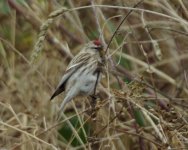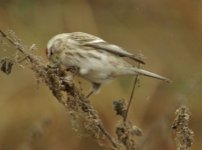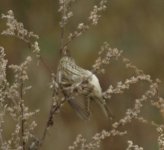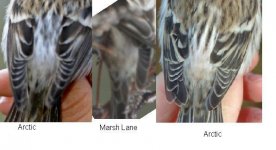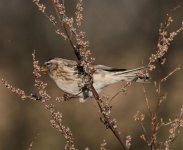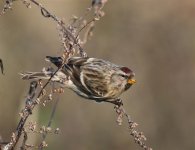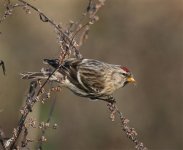Martin Garner
Well-known member
Some thoughts on the Marsh Lane ‘Arctic –like’ Redpoll.
My understanding has been informed, partly, by finding an apparent Arctic Redpoll in South Yorkshire a couple of years ago, which caused quite a few headaches, of the same nature as the Marsh Lane bird is causing, and it lead to much investigating and carefully examination of many Redpolls (including over 100 Mealy Redpolls) in the UK over the next few months. I went to see the Marsh Lane bird on 2nd and 3rd January and came to the conclusion that the plumage and structure of this bird was outside of my understanding of the range for Mealy Redpoll. I was particularly interested to test the idea that had already been promoted that the bird might be an Icelandic Redpoll. By seeing the bird in the field, especially in regard to its size, I feel that such a claim, while entirely understandable may be something of a distraction (although others will no doubt disagree!). I conveyed to Chris Batty at RBA on the 3rd that I certainly felt that in my experience it was not simply a ‘pale Mealy’ and while I did not know for sure what it was, I felt it fit the ‘exilipes Arctic box’ much better. I said the same to Nick Barlow (site manager at Marsh Lane) a couple of hours later. I think the bird is probably a 1st winter based on the tail feathers shape, wear/ pattern on the small tertials, and possibly some moult contrast in the greater coverts (though I am not totally convinced of the latter) and some pink in the cheeks. I definitely think there were two birds (the second, a fairly ‘normal’ Mealy Redpoll) due to a number of clearly observable differences in the photos taken on 27th Dec and all other photos of the ‘target bird’. It is also conceivable that some of the Lesser Redpolls may be of Scandinavian origin.
The issues I have with the Marsh Lane Redpoll are as follows:
1) The ‘rump patch’ (which really includes the lower back and small uppertail coverts) can be described, based on field views as an overall fairly extensive white patch (more so than some normal Arctic Redpolls). Often through binoculars at reasonable range it looks pretty much plain white. In flight it is quite striking and again extensive looking. At closer range the dark bases to some of the rump feathers are visible producing a vaguely grey streaked effect. The lower section of the rump/ upper small uppertail coverts has a tawny wash. My experience and understanding is that this pattern is within normal range for Arctic Redpoll (including the pattern of streaking) for female/ immature birds, The presence of greyish streaking ‘showing though’ the white rump area on some Arctic Redpolls is normal and has been well documented for some time e.g. “Many but not all adult female and immature exilipes have lightly streaked rumps” (from ID of Arctic Redpoll. BB. Vol. 84, No.2) and from BWP: 37% of 1st winter males examined and 49% of first winter females have rumps with 1-2 cm of “white with dusky streaking”. This is usually most apparent in the hand, but with the particularly close views and the quality of photos which can now be obtained of birds like this; enables such be seen in the field and recorded. So I would call the rump area of this bird overall an ‘Arctic Redpoll-like rump’ Conversely I haven’t seen a Mealy Redpoll with a rump like it apart from adult males, which are also aged and sexed by obvious reddish tones over the rump and breast; nor have I encountered any data that suggest that Mealy Redpoll in non-adult male plumage could have such a rump pattern. I have heard lots of anecdotal evidence about people seeing ‘pale Mealies’ with a rump pattern like this but as yet this is not backed up by convincing photographic evidence or data showing such birds exist. That is not to say they don’t of course, but real hard data would be good. The photos of the bird’s rump on the Internet are variously both over exposed/ under saturated and under-exposed/ over saturated, bringing some confusion especially for those commenting on the photos that have not seen the bird.
I will post some photos showing the bird’s rump. There are plenty of Arctic Redpoll rumps illustrated on the Internet, compare the Marsh lane bird, for example with this one:
http://www.pbase.com/upupa/image/65586144
and here:
http://www.praktejder.se/images/0411...1MN-041106.htm (scroll to bottom)
One specific feature in relation to the overall ‘rump pattern’, which has not been discussed, is the small uppertail coverts. Most Redpolls show a set of long rather dark brown feathers with thin pale fringes immediately adjacent to the tail. These are the 'long' uppertail coverts. Then there are a number of small uppertail coverts (which I find it hard to know where they end and the rump feathers begin). There are some general differences (maybe not diagnostic but perhaps indicative) between most flammea and exilipes in the colour and pattern of the first row of small uppertail coverts next to the long dark uppertail coverts.
In flammea the pattern is of buff feathers with a generally large dark feather centres. This makes the region of small uppertail coverts look clearly rather dark with obvious buff/ brown fringes and blackish feather centres.
In exilipes the first row of feathers is white, with more limited blackish feather centres (thus making the white rump area appear 'larger').
The Marsh lane bird has first row of feathers white with limited blackish centre, than next row of feathers more buff tinged, but lacking the stronger brown and buff effect with larger dark centres usually found on flammea.
2) The undertail covert pattern is seemingly within the normal range of variation for Arctic Redpoll albeit at the more strongly marked end. It may also be within range of pattern for non-adult male Mealy Redpoll. I don’t know. Adult male Mealies can vary from well marked to unmarked undertail coverts. The COMBINATION, however of rump and undertail coverts is, I would argue is of Arctic, rather than Mealy type combination. Again, it would be interesting to see hard data, which demonstrates that Mealy Redpoll in non-adult male plumage can show such a rump pattern/ undertail covert combination.
3) The flank streaking is quite extensive and dark, though I think within the range of variation for exilipes Arctic Redpoll. A minor observation is that in the field was that the streaks (overall) tended to appear as rather isolated, thickish ‘wisps’ and apart from the upper breast sides (tawny washed), on a relatively white background. While variable, typically on Mealy Redpoll the flanks streaking is more joined together in longer ‘cat’s claw’ streaks with a black feather centre on dark brown background. Again Mealy may appear like this but overall I felt the flank pattern was reminiscent for an Arctic type, albeit at the heavily streaked end.
4) The bill is undoubtedly at the larger end of the scale, though also quite deep-based and is not the somewhat caricatured tiny ‘pushed in’ bill of many Arctic redpolls. That some Arctic Redpolls do have larger bills very similar to this bird is also not in doubt as can be seen in photos of bird taken in Scandinavia (see also BB Vol 84 plate 40). Also check out the variation and especially the last bird on this page as others have indicated:
http://web.telia.com/~u15702529/falt...nas_nabbar.htm
and the second bird down on this page
http://www.tarsiger.com/gallery/inde...iva+DESC&sel=2
5) The scapulars in the field are of a tawny/ sandy tone, at the pale end of the range for many Mealies, and I would say within normal range of many Arctic Redpolls. The colour of the upperparts of the Marsh Lane bird as represented in a number of the photos on the Internet is too monochrome/ grey/white…though they are amazing photos!
6) The wing bars are generally very white looking, though with slight tawny wash on outer greater coverts. I think notably the white tips of the median coverts are particularly broad and clean white, perhaps more Arctic-like than Mealy like in width and whiteness, though the point is probably debatable.
7) Icelandic Redpolls. The bird could be an Icelandic Redpoll. For that matter almost any white-rumped, streakier Redpoll seen in Britain could be promoted as a pale Icelandic Redpoll. However I do have reservations about this argument:
a) I don’t think the bird was ‘long-bodied enough’ for typical North Western Redpoll, though some pale Icelandic Redpolls are arguably smaller.
b) The streaking was too ‘wispy’ lacking the more typical 3 lines of ‘cat’s claw’ streaking of (even most pale) North Western Redpoll
c) My main reservation is that there is no evidence of the normal plumage types of e.g. rostrata reaching well inland in England. The vast majority of NW Redpolls reaching the Northern Isles do not look like this bird. Many are also particularly large and would be noticeable in the field and in the ringer’s bag. None have been recorded inland ever in England as far as I know. Further the plumage of the Marsh Lane bird seems exceptional even for some pale Icelandic Redpolls according to both Icelandic and Shetland observers. I think I would rather work with the more likely scenario, that this is a bird lies in the ‘problem zone’ between Mealy and Arctic. There have been 2 other claims of Arctic Redpoll from late autumn in England, both apparently photographed: at Berwick-on-Tweed, Northumberland on 15th November and at Langham, Norfolk on 18th November (the latter with Lesser Redpolls only).
In summary I sympathise with the ‘pale Mealy’ view because of the streakiness and particularly rather large looking bill and sometimes I do feel like throwing in the towel and just calling it a pale Mealy! However I am unable to demonstrate that Mealy Redpolls in 1st winter plumage can show the rump pattern like this bird in combination with this undertail covert pattern. A number of other features of the bird including its bulkiness, upperparts tone, width and whiteness of wing bars and (to a limited extent) flank streaking have, for me, an ‘Arctic Redpoll- like’ aspect to them. Like most other commentators I don’t like the bill for Arctic. If the bill was small and ‘pushed in, would it not be just passed off fine as an Arctic?
I think I can demonstrate that all of the features which my be construed as extreme can nevertheless be found on examples of Arctic Redpoll, including the bill, flank streaking, rump pattern and undertail coverts. The unanswered question for me is whether they can all be found in one individual, such as this one!
Still learning ‘bout Redpolls!
Martin
P.S. will try (with Jane Turner's help!) and post some photos showing the rump, which I feel portray reasonably accurately its appearance in the field.
My understanding has been informed, partly, by finding an apparent Arctic Redpoll in South Yorkshire a couple of years ago, which caused quite a few headaches, of the same nature as the Marsh Lane bird is causing, and it lead to much investigating and carefully examination of many Redpolls (including over 100 Mealy Redpolls) in the UK over the next few months. I went to see the Marsh Lane bird on 2nd and 3rd January and came to the conclusion that the plumage and structure of this bird was outside of my understanding of the range for Mealy Redpoll. I was particularly interested to test the idea that had already been promoted that the bird might be an Icelandic Redpoll. By seeing the bird in the field, especially in regard to its size, I feel that such a claim, while entirely understandable may be something of a distraction (although others will no doubt disagree!). I conveyed to Chris Batty at RBA on the 3rd that I certainly felt that in my experience it was not simply a ‘pale Mealy’ and while I did not know for sure what it was, I felt it fit the ‘exilipes Arctic box’ much better. I said the same to Nick Barlow (site manager at Marsh Lane) a couple of hours later. I think the bird is probably a 1st winter based on the tail feathers shape, wear/ pattern on the small tertials, and possibly some moult contrast in the greater coverts (though I am not totally convinced of the latter) and some pink in the cheeks. I definitely think there were two birds (the second, a fairly ‘normal’ Mealy Redpoll) due to a number of clearly observable differences in the photos taken on 27th Dec and all other photos of the ‘target bird’. It is also conceivable that some of the Lesser Redpolls may be of Scandinavian origin.
The issues I have with the Marsh Lane Redpoll are as follows:
1) The ‘rump patch’ (which really includes the lower back and small uppertail coverts) can be described, based on field views as an overall fairly extensive white patch (more so than some normal Arctic Redpolls). Often through binoculars at reasonable range it looks pretty much plain white. In flight it is quite striking and again extensive looking. At closer range the dark bases to some of the rump feathers are visible producing a vaguely grey streaked effect. The lower section of the rump/ upper small uppertail coverts has a tawny wash. My experience and understanding is that this pattern is within normal range for Arctic Redpoll (including the pattern of streaking) for female/ immature birds, The presence of greyish streaking ‘showing though’ the white rump area on some Arctic Redpolls is normal and has been well documented for some time e.g. “Many but not all adult female and immature exilipes have lightly streaked rumps” (from ID of Arctic Redpoll. BB. Vol. 84, No.2) and from BWP: 37% of 1st winter males examined and 49% of first winter females have rumps with 1-2 cm of “white with dusky streaking”. This is usually most apparent in the hand, but with the particularly close views and the quality of photos which can now be obtained of birds like this; enables such be seen in the field and recorded. So I would call the rump area of this bird overall an ‘Arctic Redpoll-like rump’ Conversely I haven’t seen a Mealy Redpoll with a rump like it apart from adult males, which are also aged and sexed by obvious reddish tones over the rump and breast; nor have I encountered any data that suggest that Mealy Redpoll in non-adult male plumage could have such a rump pattern. I have heard lots of anecdotal evidence about people seeing ‘pale Mealies’ with a rump pattern like this but as yet this is not backed up by convincing photographic evidence or data showing such birds exist. That is not to say they don’t of course, but real hard data would be good. The photos of the bird’s rump on the Internet are variously both over exposed/ under saturated and under-exposed/ over saturated, bringing some confusion especially for those commenting on the photos that have not seen the bird.
I will post some photos showing the bird’s rump. There are plenty of Arctic Redpoll rumps illustrated on the Internet, compare the Marsh lane bird, for example with this one:
http://www.pbase.com/upupa/image/65586144
and here:
http://www.praktejder.se/images/0411...1MN-041106.htm (scroll to bottom)
One specific feature in relation to the overall ‘rump pattern’, which has not been discussed, is the small uppertail coverts. Most Redpolls show a set of long rather dark brown feathers with thin pale fringes immediately adjacent to the tail. These are the 'long' uppertail coverts. Then there are a number of small uppertail coverts (which I find it hard to know where they end and the rump feathers begin). There are some general differences (maybe not diagnostic but perhaps indicative) between most flammea and exilipes in the colour and pattern of the first row of small uppertail coverts next to the long dark uppertail coverts.
In flammea the pattern is of buff feathers with a generally large dark feather centres. This makes the region of small uppertail coverts look clearly rather dark with obvious buff/ brown fringes and blackish feather centres.
In exilipes the first row of feathers is white, with more limited blackish feather centres (thus making the white rump area appear 'larger').
The Marsh lane bird has first row of feathers white with limited blackish centre, than next row of feathers more buff tinged, but lacking the stronger brown and buff effect with larger dark centres usually found on flammea.
2) The undertail covert pattern is seemingly within the normal range of variation for Arctic Redpoll albeit at the more strongly marked end. It may also be within range of pattern for non-adult male Mealy Redpoll. I don’t know. Adult male Mealies can vary from well marked to unmarked undertail coverts. The COMBINATION, however of rump and undertail coverts is, I would argue is of Arctic, rather than Mealy type combination. Again, it would be interesting to see hard data, which demonstrates that Mealy Redpoll in non-adult male plumage can show such a rump pattern/ undertail covert combination.
3) The flank streaking is quite extensive and dark, though I think within the range of variation for exilipes Arctic Redpoll. A minor observation is that in the field was that the streaks (overall) tended to appear as rather isolated, thickish ‘wisps’ and apart from the upper breast sides (tawny washed), on a relatively white background. While variable, typically on Mealy Redpoll the flanks streaking is more joined together in longer ‘cat’s claw’ streaks with a black feather centre on dark brown background. Again Mealy may appear like this but overall I felt the flank pattern was reminiscent for an Arctic type, albeit at the heavily streaked end.
4) The bill is undoubtedly at the larger end of the scale, though also quite deep-based and is not the somewhat caricatured tiny ‘pushed in’ bill of many Arctic redpolls. That some Arctic Redpolls do have larger bills very similar to this bird is also not in doubt as can be seen in photos of bird taken in Scandinavia (see also BB Vol 84 plate 40). Also check out the variation and especially the last bird on this page as others have indicated:
http://web.telia.com/~u15702529/falt...nas_nabbar.htm
and the second bird down on this page
http://www.tarsiger.com/gallery/inde...iva+DESC&sel=2
5) The scapulars in the field are of a tawny/ sandy tone, at the pale end of the range for many Mealies, and I would say within normal range of many Arctic Redpolls. The colour of the upperparts of the Marsh Lane bird as represented in a number of the photos on the Internet is too monochrome/ grey/white…though they are amazing photos!
6) The wing bars are generally very white looking, though with slight tawny wash on outer greater coverts. I think notably the white tips of the median coverts are particularly broad and clean white, perhaps more Arctic-like than Mealy like in width and whiteness, though the point is probably debatable.
7) Icelandic Redpolls. The bird could be an Icelandic Redpoll. For that matter almost any white-rumped, streakier Redpoll seen in Britain could be promoted as a pale Icelandic Redpoll. However I do have reservations about this argument:
a) I don’t think the bird was ‘long-bodied enough’ for typical North Western Redpoll, though some pale Icelandic Redpolls are arguably smaller.
b) The streaking was too ‘wispy’ lacking the more typical 3 lines of ‘cat’s claw’ streaking of (even most pale) North Western Redpoll
c) My main reservation is that there is no evidence of the normal plumage types of e.g. rostrata reaching well inland in England. The vast majority of NW Redpolls reaching the Northern Isles do not look like this bird. Many are also particularly large and would be noticeable in the field and in the ringer’s bag. None have been recorded inland ever in England as far as I know. Further the plumage of the Marsh Lane bird seems exceptional even for some pale Icelandic Redpolls according to both Icelandic and Shetland observers. I think I would rather work with the more likely scenario, that this is a bird lies in the ‘problem zone’ between Mealy and Arctic. There have been 2 other claims of Arctic Redpoll from late autumn in England, both apparently photographed: at Berwick-on-Tweed, Northumberland on 15th November and at Langham, Norfolk on 18th November (the latter with Lesser Redpolls only).
In summary I sympathise with the ‘pale Mealy’ view because of the streakiness and particularly rather large looking bill and sometimes I do feel like throwing in the towel and just calling it a pale Mealy! However I am unable to demonstrate that Mealy Redpolls in 1st winter plumage can show the rump pattern like this bird in combination with this undertail covert pattern. A number of other features of the bird including its bulkiness, upperparts tone, width and whiteness of wing bars and (to a limited extent) flank streaking have, for me, an ‘Arctic Redpoll- like’ aspect to them. Like most other commentators I don’t like the bill for Arctic. If the bill was small and ‘pushed in, would it not be just passed off fine as an Arctic?
I think I can demonstrate that all of the features which my be construed as extreme can nevertheless be found on examples of Arctic Redpoll, including the bill, flank streaking, rump pattern and undertail coverts. The unanswered question for me is whether they can all be found in one individual, such as this one!
Still learning ‘bout Redpolls!
Martin
P.S. will try (with Jane Turner's help!) and post some photos showing the rump, which I feel portray reasonably accurately its appearance in the field.




